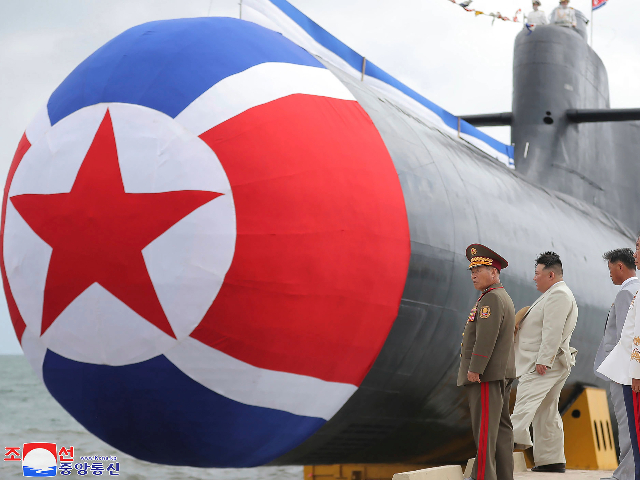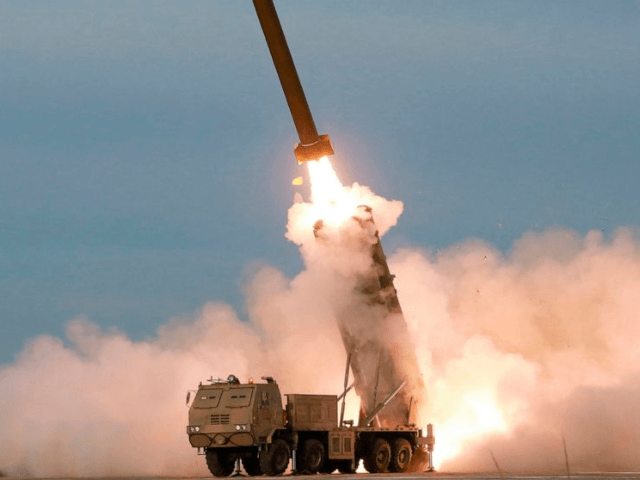North Korea is believed to possess 50 nuclear weapons – 20 more than in the past year, the Stockholm International Peace Research Institute (SIPRI) revealed in its annual report published on Monday on global militaries.
SIPRI’s “Yearbook 2024 Armaments, Disarmament and International Security” report assesses the known arsenals of nuclear states as well as global military development. It once again found that the vast majority of known nuclear weapons are in the possession of America and Russia, but that communist China is making significant efforts to expand and modernize its own arsenal. Notably, the report documented “the first time China is believed to have some warheads on high operational alert” in 2024.
In its section on North Korea, SIPRI warned that evidence suggests communist dictator Kim Jong-un is “putting new emphasis” on Pyongyang’s nuclear assets.
“SIPRI estimates that the country has now assembled around 50 warheads and possesses enough fissile material to reach a total of up to 90 warheads,” the report found, “both significant increases over the estimates for January 2023.”
“While North Korea conducted no nuclear test explosions in 2023, it appears to have carried out its first test of a short-range ballistic missile from a rudimentary silo,” SIPRI noted. “It also completed the development of at least two types of land-attack cruise missile (LACM) designed to deliver nuclear weapons.”
In 2023, SIPRI estimated that North Korea possessed 30 assembled warheads. North Korea has not tested a nuclear weapon since 2017 but regularly threatens to use its nuclear weapons against South Korea, in which it is in a state of formal war halted only by an armistice agreement signed in 1953.

In this photo provided by the North Korean government, North Korea leader Kim Jong Un, second left, looks at what is says a new nuclear attack submarine . (Korean Central News Agency/Korea News Service via AP)
Matt Korda, Associate Researcher with SIPRI’s Weapons of Mass Destruction Programme, said in a press release accompanying the report that the sudden increase in nuclear development by North Korea is feeding “growing concern that North Korea might intend to use these weapons very early in a conflict.”
For decades, North Korean state media refused to identify South Korea as a separate country, referring to it as “south Korea” and its government as a rogue separatist entity fighting the rightful communist government of a unified Korea. This policy came to an end in January, when Kim Jong-un began referring to South Korea by its formal name, the Republic of Korea (ROK), and stated Pyongyang would not attempt to prevent the resumption of a hot war with its southern neighbor.
“The ROK scums are our principal enemy,” Kim said in an address that month. “While we will not unilaterally decide on a major upheaval in the Korean peninsula through the overwhelming force of ours, we also have no intention of avoiding war.”
The Korean Central News Agency (KCNA), the state news outlet of North Korea, announced in April that Kim Jong-un had allegedly led a “combined tactical drill simulating a nuclear counterattack,” an escalation implying North Korea was preparing to use a nuclear bomb. The drill allegedly sent “a clear warning signal to the enemies as it was conducted at a time when the enemies’ military confrontation racket against the DPRK [North Korea] is being committed with extremely provocative and aggressive nature.”
Tensions surged between the Koreas in the past week as North Korea began a campaign of launching hundreds of balloons carrying trash and feces across the border – allegedly a response to political pamphlets that independent activists have often floated across the border north in an attempt to given North Koreans banned information about the outside world.
“Once you experience how nasty and exhausting it feels to go around picking up dirty filth, you will realize that you shouldn’t talk about freedom of expression so easily when it comes to [spreading leaflets] in border areas,” Kim Yo-jong, a senior North Korean official and Kim Jong-un’s sister, declared in a statement published by KCNA.

Japan Defense Paper This Aug. 24, 2019, file photo provided by the North Korean government, shows the test firing of an unspecified missile at an undisclosed location in North Korea.(Korean Central News Agency/Korea News Service via AP, File)
South Korea reacted to the trash balloons by reinstalling massive loudspeakers in the Demilitarized Zone (DMZ) used to broadcast hours of content – including news of South Korea, political messages, and Korean pop music – to the North.
“The responses we take may be difficult for the North Korean regime to endure, but will deliver news of light and hope to the North’s military and residents,” South Korea’s National Security Council said in a statement before playing hits by the South Korean superstar boy band BTS across the DMZ.
North Korea’s 50 warheads were counted alongside a complete global nuclear tally of 12,121 existing warheads as of January 2024. About a third of these – 3,904 – are believed to be actively deployed. Over 90 percent of them belong to Russia – whose leader Vladimir Putin is expected in Pyongyang this week – and America.
‘While the global total of nuclear warheads continues to fall as cold war-era weapons are gradually dismantled, regrettably we continue to see year-on-year increases in the number of operational nuclear warheads,’ SIPRI Director Dan Smith said in a statement. ‘This trend seems likely to continue and probably accelerate in the coming years and is extremely concerning.”





Comments are closed.